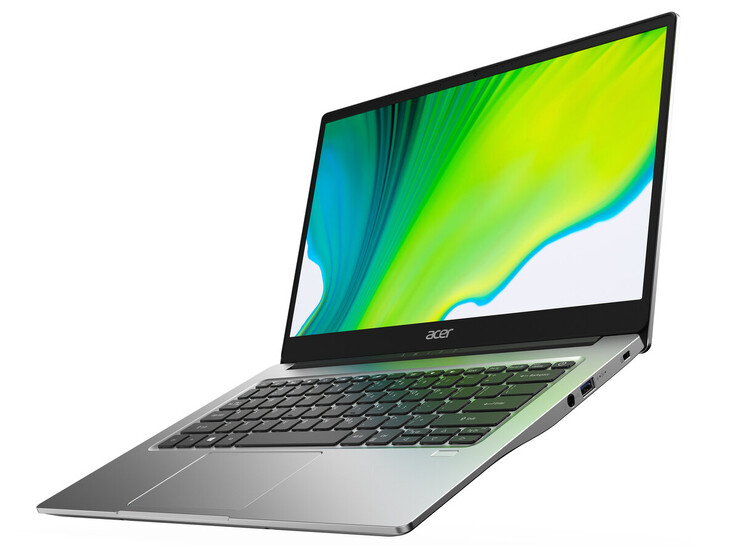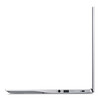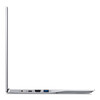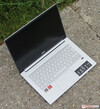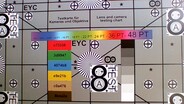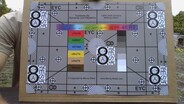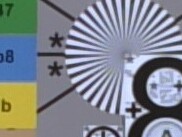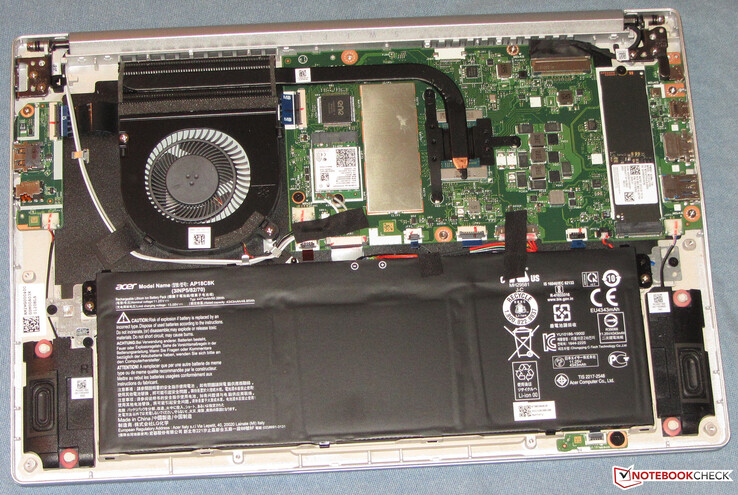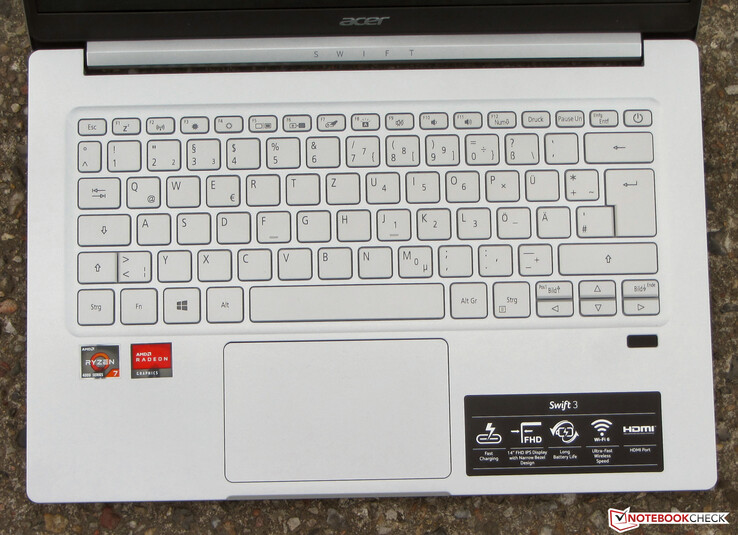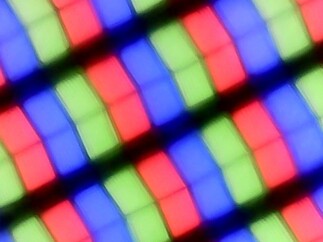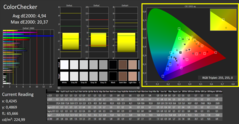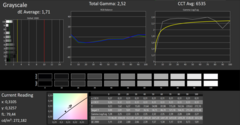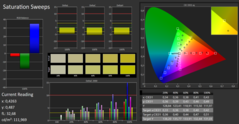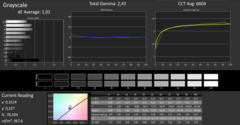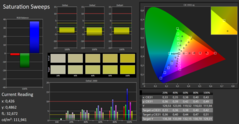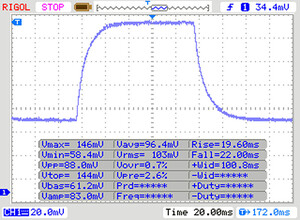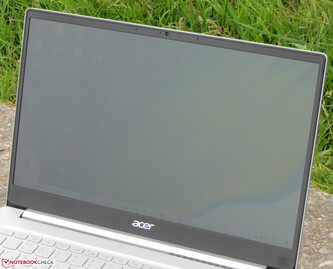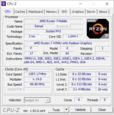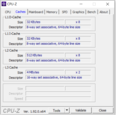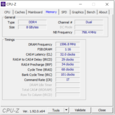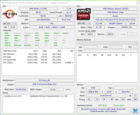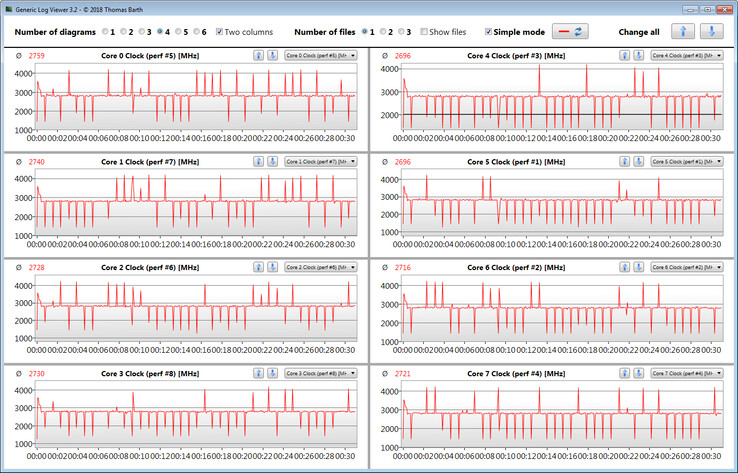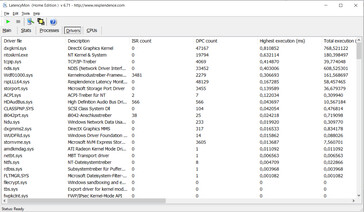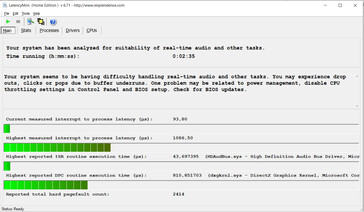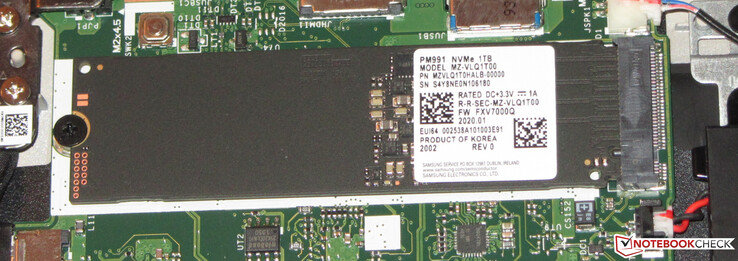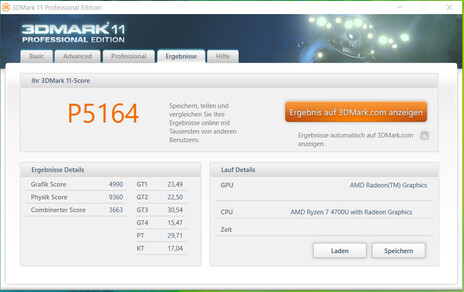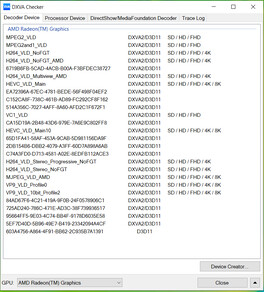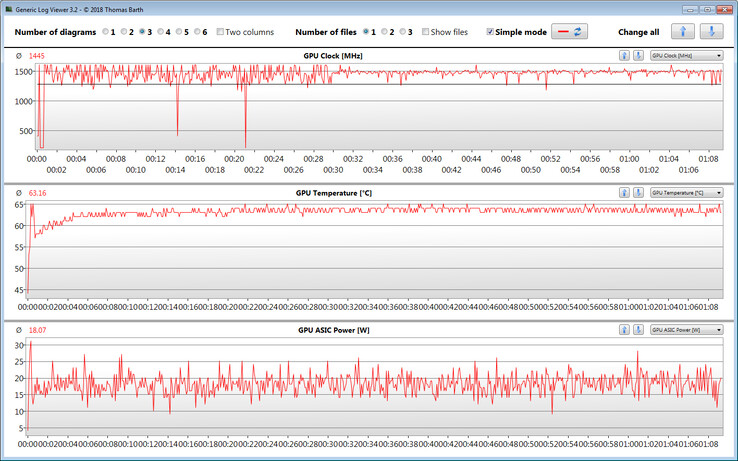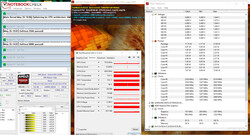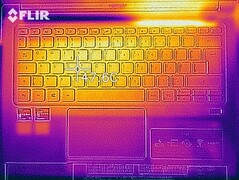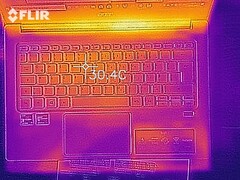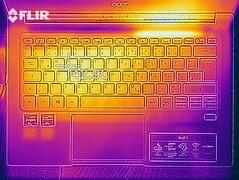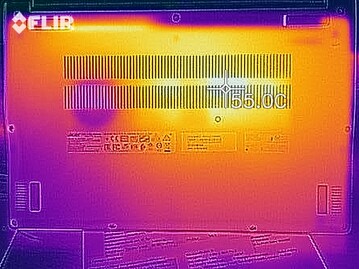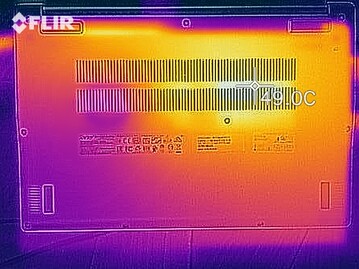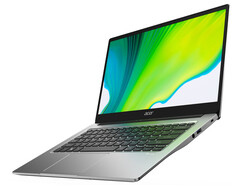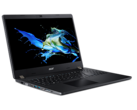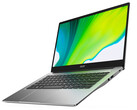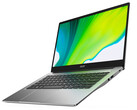Acer Swift 3 SF314-42 Laptop Review: Fast, slim and with good battery life - The Ryzen subnotebook is almost completely convincing

Acer's Swift 3 SF314-42 is a chic and compact 14-inch laptop. The device succeeds the SF314-41, a device that AMD released last year. While the SF314-41 had an AMD Picasso APU on board, the new Swift 3 has a Renoir APU. In the case of our review unit, we find a Ryzen 7 4700U, an eight-core APU that does without Simultaneous MultiThreading (SMT). Competitors of the SF314-42 include the Honor Magicbook 14, MSI Modern 14 A10RB, Asus ZenBook 14 UM431DA, Lenovo IdeaPad S540-14IWL, IdeaPad S540-14API and the HP Pavilion 14.
Rating | Date | Model | Weight | Height | Size | Resolution | Price |
|---|---|---|---|---|---|---|---|
| 86.5 % v7 (old) | 06 / 2020 | Acer Swift 3 SF314-42-R4XJ R7 4700U, Vega 7 | 1.2 kg | 16.55 mm | 14.00" | 1920x1080 | |
| 82.7 % v7 (old) | 11 / 2019 | Acer Swift 3 SF314-41-R8HZ R5 3500U, Vega 8 | 1.5 kg | 18 mm | 14.00" | 1920x1080 | |
| 86.5 % v7 (old) | 05 / 2020 | Honor Magicbook 14 R5 3500U, Vega 8 | 1.4 kg | 16 mm | 14.00" | 1920x1080 | |
| 80.9 % v7 (old) | 01 / 2020 | MSI Modern 14 A10RB-459US i5-10210U, GeForce MX250 | 1.2 kg | 16 mm | 14.00" | 1920x1080 | |
| 81.2 % v7 (old) | 02 / 2020 | Asus ZenBook 14 UM431DA-AM020T R7 3700U, Vega 10 | 1.4 kg | 16 mm | 14.00" | 1920x1080 | |
| 84.2 % v6 (old) | 12 / 2019 | Lenovo IdeaPad S540-14API R7 3700U, Vega 10 | 1.4 kg | 15.9 mm | 14.00" | 1920x1080 | |
| 84.9 % v6 (old) | 07 / 2019 | Lenovo IdeaPad S540-14IWL i5-8265U, GeForce MX250 | 1.4 kg | 15.9 mm | 14.00" | 1920x1080 | |
| 77.8 % v7 (old) | 01 / 2020 | HP Pavilion 14-ce3040ng i7-1065G7, GeForce MX250 | 1.6 kg | 18 mm | 14.00" | 1920x1080 |
Case - Stylish metal housing for the Swift SF314
Acer has given the SF314-42, like its predecessor, a stylish and slim metal case. The chassis has a matte silver finish, which Acer has contrasted with a black plastic display frame. Acer has used smooth surfaces throughout. There is no maintenance hatch though, so accessing the machine's internal components requires some disassembly. We shall discuss this in the Maintenance section of this review.
The processing of our review unit does not give rise to any criticisms. Gaps between materials are precise, and nothing protrudes in any way. The device also does not reveal any serious stability problems. The base unit can be twisted a bit, but not concerningly so. The same applies to the lid. Applying pressure on the back of the lid does not cause the display to distort at all. The display is held in place by pleasingly tight hinges. These hold the lid firmly in place, with the display barely teetering as we use it. The hinges allow the display to be opened up to 180°, for reference. It is possible to open the lid with one hand, too.
The dimensions of the devices in our comparison field do not differ excessively. The Swift 3, along with the MSI Modern 14, weigh the least of the eight devices. The previous Swift 3 is slightly heavier and bulkier than its successor.
Connectivity - USB Type-C is on board
The laptop has two USB Type-A ports, with one operating at the USB 2.0 standard and the other on the newer USB 3.2 Gen1 standard. There is also a USB Type-C port that utilises the latest USB 3.2 Gen2 standard. The latter supports both DisplayPort and USB Power Delivery (PD), meaning that the device can output audio and video while being charged. Acer has still included a full-sized HDMI port and a power connector though, giving the Swift 3 two charging and video outputs. The laptop does not have a memory card reader.
Communication
Acer has equipped the Swift 3 with an Intel Wi-Fi 6 AX200, a modem that not only supports the 802.11a/b/g/n/ac Wi-Fi, but also the newer ax standard. Additionally, the AX200 offers Bluetooth 5.0 functionality. Our table below represents optimal Wi-Fi conditions with no other Wi-Fi devices placed between our review unit and our router. We positioned the laptop and our router closely, too.
Webcam
Acer has also equipped the Swift 3 with a 720p webcam. The results are somewhat washed-out and lacking in colour accuracy. With a Delta E deviation of just under 12, the Swift 3 misses our ideal target of 3 by a wide margin.
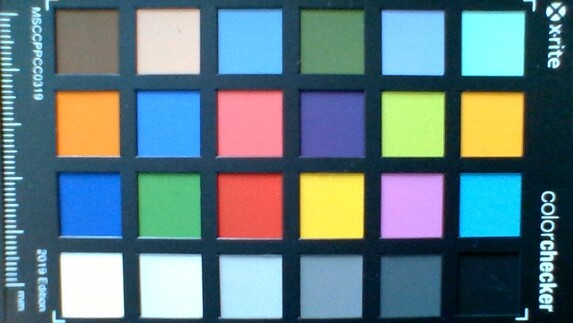
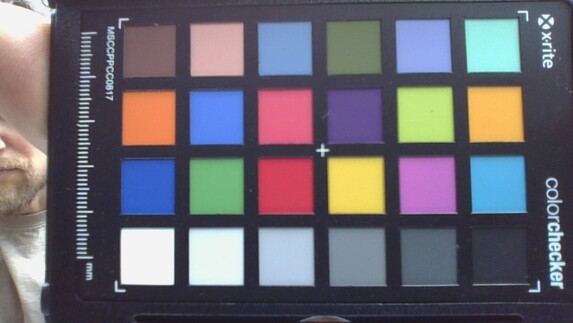
Accessories
In addition to the usual documents like warranty information and a quick-start guide, Acer includes a power supply in the box. No other accessories are included, though.
Maintenance
The Swift 3 does not have a maintenance hatch, as we mentioned earlier. Nevertheless, the innards are relatively easy to access. After removing all of the screws on the underside of the device, the lower shell can be removed using a pry tool or a flat spatula.
Warranty
Acer grants its slim 14-inch laptop a two-year warranty. The warranty coverage extends to a pick-up service. Acer offers a three-year warranty package for around 50 Euros (~$57). Please see our Guarantees, Return Policies & Warranties FAQ for country-specific information.
Input Devices - Acer has included a backlit keyboard
Keyboard
Acer has equipped its 14-inch device with a backlit chiclet keyboard. Its flat, smooth keys offer a short drop and a clear pressure point. The keys have an acceptable level of resistance, too. The keyboard gives way a little while typing, but not excessively so. The single-stage backlight is controlled using a function key. All in all, Acer has included a good everyday keyboard here.
Touchpad
The multi-touch touchpad occupies an area of approximately 10.5 x 6.5 cm. This means that there is plenty of space on which to perform gesture controls. The touchpad has a smooth finish, which makes it easy for one to glide their fingers across its surface. Our review unit remains accurate into its corners, while the integrated mouse buttons have a defined stroke and clear pressure points.
Display - A matte but dark IPS display
The matte 14-inch screen of the Acer Swift 3 works natively at 1920x1080 pixels. It offers a good contrast ratio of 1,170:1, but its maximum brightness of 244.1 cd/m² is too low in our view. A 1,000-Euro (~$1,134) laptop should offer more in this regard or at least a peak brightness of 300 cd/m². Positively, the display does not suffer from any PWM flickering.
| |||||||||||||||||||||||||
Brightness Distribution: 83 %
Center on Battery: 270 cd/m²
Contrast: 1170:1 (Black: 0.23 cd/m²)
ΔE ColorChecker Calman: 4.94 | ∀{0.5-29.43 Ø4.77}
calibrated: 5.03
ΔE Greyscale Calman: 1.71 | ∀{0.09-98 Ø5}
56% sRGB (Argyll 1.6.3 3D)
35% AdobeRGB 1998 (Argyll 1.6.3 3D)
38.43% AdobeRGB 1998 (Argyll 3D)
55.9% sRGB (Argyll 3D)
37.2% Display P3 (Argyll 3D)
Gamma: 2.52
CCT: 6535 K
| Acer Swift 3 SF314-42-R4XJ IPS, 1920x1080, 14" | Acer Swift 3 SF314-41-R8HZ IPS, 1920x1080, 14" | Honor Magicbook 14 IPS, 1920x1080, 14" | MSI Modern 14 A10RB-459US IPS, 1920x1080, 14" | Asus ZenBook 14 UM431DA-AM020T IPS, 1920x1080, 14" | Lenovo IdeaPad S540-14API IPS, 1920x1080, 14" | Lenovo IdeaPad S540-14IWL IPS, 1920x1080, 14" | HP Pavilion 14-ce3040ng IPS, 1920x1080, 14" | |
|---|---|---|---|---|---|---|---|---|
| Display | 11% | 20% | 71% | 73% | 4% | 7% | 77% | |
| Display P3 Coverage (%) | 37.2 | 41.43 11% | 44.93 21% | 64.2 73% | 66.7 79% | 38.8 4% | 40.1 8% | 66.5 79% |
| sRGB Coverage (%) | 55.9 | 61.8 11% | 66.2 18% | 94.8 70% | 92.3 65% | 58.4 4% | 59.2 6% | 98.4 76% |
| AdobeRGB 1998 Coverage (%) | 38.43 | 42.85 12% | 46.42 21% | 65.4 70% | 67.5 76% | 40.09 4% | 41.43 8% | 68.2 77% |
| Response Times | -1% | -23% | -19% | 4% | 3% | -13% | -33% | |
| Response Time Grey 50% / Grey 80% * (ms) | 41 ? | 38 ? 7% | 44.8 ? -9% | 39.2 ? 4% | 36 ? 12% | 38.8 ? 5% | 39.6 ? 3% | 60.8 ? -48% |
| Response Time Black / White * (ms) | 25 ? | 27 ? -8% | 34 ? -36% | 35.6 ? -42% | 26 ? -4% | 24.8 ? 1% | 32 ? -28% | 29.6 ? -18% |
| PWM Frequency (Hz) | 250 ? | 5952 ? | 25000 ? | 44 ? | 352.1 ? | |||
| Screen | -14% | 6% | 37% | -14% | -24% | -0% | 10% | |
| Brightness middle (cd/m²) | 269 | 233 -13% | 311 16% | 324.1 20% | 253 -6% | 271 1% | 316 17% | 395 47% |
| Brightness (cd/m²) | 244 | 219 -10% | 296 21% | 301 23% | 245 0% | 257 5% | 301 23% | 375 54% |
| Brightness Distribution (%) | 83 | 75 -10% | 92 11% | 87 5% | 78 -6% | 91 10% | 88 6% | 91 10% |
| Black Level * (cd/m²) | 0.23 | 0.14 39% | 0.18 22% | 0.22 4% | 0.225 2% | 0.27 -17% | 0.28 -22% | 0.26 -13% |
| Contrast (:1) | 1170 | 1664 42% | 1728 48% | 1473 26% | 1124 -4% | 1004 -14% | 1129 -4% | 1519 30% |
| Colorchecker dE 2000 * | 4.94 | 5.9 -19% | 5.3 -7% | 1.63 67% | 8.89 -80% | 6.8 -38% | 5.3 -7% | 5.92 -20% |
| Colorchecker dE 2000 max. * | 20.37 | 22.8 -12% | 18.5 9% | 4.25 79% | 4.56 78% | 14.2 30% | 18.5 9% | 9.79 52% |
| Colorchecker dE 2000 calibrated * | 5.03 | 4.2 17% | 1.42 72% | 4.9 3% | 4.2 17% | 4.8 5% | 0.91 82% | |
| Greyscale dE 2000 * | 1.71 | 4.8 -181% | 3.5 -105% | 2.2 -29% | 6.33 -270% | 6.3 -268% | 2.4 -40% | 6.69 -291% |
| Gamma | 2.52 87% | 2.06 107% | 2.1 105% | 2.26 97% | 2.52 87% | 2.49 88% | 2.05 107% | 2.78 79% |
| CCT | 6535 99% | 6589 99% | 7078 92% | 6887 94% | 6745 96% | 7845 83% | 6644 98% | 7596 86% |
| Color Space (Percent of AdobeRGB 1998) (%) | 35 | 39 11% | 42.5 21% | 60.2 72% | 60 71% | 36.9 5% | 37.6 7% | 63 80% |
| Color Space (Percent of sRGB) (%) | 56 | 62 11% | 65.8 18% | 95 70% | 91 63% | 58.3 4% | 58.3 4% | 98 75% |
| Total Average (Program / Settings) | -1% /
-7% | 1% /
5% | 30% /
37% | 21% /
5% | -6% /
-15% | -2% /
-0% | 18% /
17% |
* ... smaller is better
When delivered, the screen had a fairly decent colour-space coverage and a Delta-E-2000 colour deviation of just under 5. This still falls short of our ideal DeltaE target of 3, though. The display does not suffer from a blue tint, either. Calibrating the display yielded minimal improvements. Even after additional calibration, the display can only cover 35% of the AdobeRGB and 56% of the sRGB colour spaces.
Display Response Times
| ↔ Response Time Black to White | ||
|---|---|---|
| 25 ms ... rise ↗ and fall ↘ combined | ↗ 14 ms rise | |
| ↘ 11 ms fall | ||
| The screen shows relatively slow response rates in our tests and may be too slow for gamers. In comparison, all tested devices range from 0.1 (minimum) to 240 (maximum) ms. » 58 % of all devices are better. This means that the measured response time is worse than the average of all tested devices (20.2 ms). | ||
| ↔ Response Time 50% Grey to 80% Grey | ||
| 41 ms ... rise ↗ and fall ↘ combined | ↗ 19 ms rise | |
| ↘ 22 ms fall | ||
| The screen shows slow response rates in our tests and will be unsatisfactory for gamers. In comparison, all tested devices range from 0.165 (minimum) to 636 (maximum) ms. » 64 % of all devices are better. This means that the measured response time is worse than the average of all tested devices (31.6 ms). | ||
Screen Flickering / PWM (Pulse-Width Modulation)
| Screen flickering / PWM not detected | |||
In comparison: 53 % of all tested devices do not use PWM to dim the display. If PWM was detected, an average of 8088 (minimum: 5 - maximum: 343500) Hz was measured. | |||
The SF314-32 comes with an IPS panel that has stable viewing angles. Thus, the screen can be read from practically any position. The display's low maximum brightness prevents the Swift 3 from being used outdoors, though. Hence, the device is primarily designed for use indoors.
Performance - This Acer laptop has a lot of performance
The Acer Swift 3 SF314-42 is a stylish and slim 14-inch laptop, as we have mentioned earlier. Nonetheless, it offers more than enough computing power for all common programs and uses. Our review unit retails for just under 1,000 Euros (~$1,134), but other configurations are available from 600 Euros (~$680).
Processor
The Swift 3 is powered by a Ryzen 7 4700U, an APU that AMD has based on its Renoir architecture. Overall, the APU has made an excellent impression upon us. The Zen 2 architecture used here provides a clear increase in performance compared to the Zen+ architecture found in the Ryzen 3000 Picasso APUs. The improvements made by AMD, which include changes to the microarchitecture, a smaller structure width, and improved branch prediction, have paid off.
The CPU part of the APU consists of an eight-core processor that works at a base clock speed of 2.0 GHz. The processor can turbo up to 4.2 GHz, but it does not support Simultaneous MultiThreading (SMT), meaning it can only execute one thread per core.
In our tests, the Ryzen 7 4700U can briefly maintain 3.5 GHz in multithreaded benchmarks like Cinebench before dropping to 3.1-3.2 GHz and then eventually to 2.7-2.8 GHz. By contrast, the APU fluctuates between 1.4 and 4.2 GHz in single-threaded benchmarks. This only applies when the Swift 3 is on charge, though. Unhooking it from the mains results in recorded clock speeds of 3-3.1 GHz (multithread) and 1.4-4.2 GHz (single-thread), respectively.
We also checked whether the CPU used its turbo clock speeds permanently when running on mains power. We did so by running the Cinebench R15 Multi 64Bit on a continuous loop for at least 30 minutes. The results drop from the first to the second run and then remain at a relatively constant level. The turbo is used throughout but not permanently so.
Nevertheless, the processor does an excellent job compared to the competition. It leaves the Intel Core i7-1065G7, its direct competitor, in its wake. The Core i7-1065G7 is a quad-core processor that supports Intel's Hyper-Threading technology, for reference. Our database currently contains the Cinebench R15 Multi 64Bit loop test results from 19 different Core i7-1065G7 powered laptops, but not one can match the performance that the Ryzen 7 4700U in the Swift 3 offers. However, the Renoir APU ties with the Core i7-1065G7 on single-threaded performance, which is more important for everyday usage.
| LibreOffice - 20 Documents To PDF | |
| Average AMD Ryzen 7 4700U (55.5 - 115.7, n=8) | |
| Acer Swift 3 SF314-42-R4XJ | |
| Average of class Subnotebook (38.5 - 220, n=67, last 2 years) | |
| R Benchmark 2.5 - Overall mean | |
| Honor Magicbook 14 | |
| Acer Swift 3 SF314-42-R4XJ | |
| Average AMD Ryzen 7 4700U (0.598 - 0.651, n=8) | |
| Average of class Subnotebook (0.403 - 1.456, n=69, last 2 years) | |
| Mozilla Kraken 1.1 - Total | |
| Lenovo IdeaPad S540-14API (Edge: 44.17763.1.0) | |
| Acer Swift 3 SF314-41-R8HZ (Edge 44) | |
| Lenovo IdeaPad S540-14IWL (Edge: 44.18362.1.0) | |
| MSI Modern 14 A10RB-459US (Edge 44.18362.449.0) | |
| Honor Magicbook 14 (Chrome 82) | |
| Acer Swift 3 SF314-42-R4XJ (Edge 44) | |
| Acer Swift 3 SF314-42-R4XJ (Chrome 82) | |
| Average AMD Ryzen 7 4700U (805 - 954, n=9) | |
| Average of class Subnotebook (265 - 1104, n=72, last 2 years) | |
| Octane V2 - Total Score | |
| Average of class Subnotebook (35801 - 120964, n=36, last 2 years) | |
| Average AMD Ryzen 7 4700U (34607 - 51878, n=4) | |
| Acer Swift 3 SF314-42-R4XJ (Edge 44) | |
| Lenovo IdeaPad S540-14IWL (Edge: 44.18362.1.0) | |
| MSI Modern 14 A10RB-459US (Edge 44.18362.449.0) | |
| Acer Swift 3 SF314-41-R8HZ (Edge 44) | |
| Lenovo IdeaPad S540-14API (Edge: 44.17763.1.0) | |
| Honor Magicbook 14 (Edge 44.18362.449.0) | |
| JetStream 1.1 - Total Score | |
| Average of class Subnotebook (215 - 476, n=2, last 2 years) | |
| Acer Swift 3 SF314-42-R4XJ (Edge 44) | |
| Average AMD Ryzen 7 4700U (241 - 265, n=3) | |
| MSI Modern 14 A10RB-459US (Edge 44.18362.449.0) | |
| Acer Swift 3 SF314-41-R8HZ (Edge 44) | |
| Honor Magicbook 14 (Edge 44.18362.449.0) | |
* ... smaller is better
System Performance
Our review unit works smoothly and quickly. We have not encountered any problems during our tests, with the computer offering enough performance for general office and internet-based applications. The relatively powerful iGPU also makes the Swift 3 capable of some light gaming. PCMark benchmark results are good, too. Positively, the machine's 8 GB of RAM works in dual-channel mode.
| PCMark 8 Home Score Accelerated v2 | 4191 points | |
| PCMark 8 Creative Score Accelerated v2 | 4436 points | |
| PCMark 8 Work Score Accelerated v2 | 5361 points | |
| PCMark 10 Score | 4886 points | |
Help | ||
DPC Latencies
| DPC Latencies / LatencyMon - interrupt to process latency (max), Web, Youtube, Prime95 | |
| Acer Swift 3 SF314-42-R4XJ | |
* ... smaller is better
Storage Devices
| Acer Swift 3 SF314-42-R4XJ Samsung PM991 MZVLQ1T0HALB | Acer Swift 3 SF314-41-R8HZ WDC PC SN520 SDAPNUW-512G | Honor Magicbook 14 Samsung SSD PM981a MZVLB256HBHQ | MSI Modern 14 A10RB-459US Kingston RBUSNS8154P3512GJ | Asus ZenBook 14 UM431DA-AM020T SK hynix BC501 HFM512GDHTNG-8310A | Lenovo IdeaPad S540-14API Samsung SSD PM981 MZVLB512HAJQ | Lenovo IdeaPad S540-14IWL Samsung SSD PM981 MZVLB512HAJQ | HP Pavilion 14-ce3040ng Toshiba XG6 KXG60ZNV1T02 | Average Samsung PM991 MZVLQ1T0HALB | |
|---|---|---|---|---|---|---|---|---|---|
| CrystalDiskMark 5.2 / 6 | -5% | 28% | -14% | -22% | 22% | 17% | 50% | 11% | |
| Write 4K (MB/s) | 98.8 | 134.3 36% | 137.7 39% | 107.7 9% | 118.8 20% | 144.3 46% | 157.6 60% | 181.6 84% | 139.1 ? 41% |
| Read 4K (MB/s) | 32.44 | 43.56 34% | 42.49 31% | 39.73 22% | 41.62 28% | 44.88 38% | 46.39 43% | 57.4 77% | 42.3 ? 30% |
| Write Seq (MB/s) | 1582 | 1434 -9% | 2341 48% | 926 -41% | 796 -50% | 1940 23% | 1214 -23% | 1982 25% | 1397 ? -12% |
| Read Seq (MB/s) | 1471 | 1448 -2% | 2436 66% | 1014 -31% | 1101 -25% | 2175 48% | 1295 -12% | 1899 29% | 1608 ? 9% |
| Write 4K Q32T1 (MB/s) | 375.4 | 239.1 -36% | 261 -30% | 343.6 -8% | 234.7 -37% | 272.2 -27% | 370.7 -1% | 509 36% | 420 ? 12% |
| Read 4K Q32T1 (MB/s) | 491.9 | 327.6 -33% | 335.4 -32% | 499.1 1% | 313.8 -36% | 360.3 -27% | 461.1 -6% | 545 11% | 479 ? -3% |
| Write Seq Q32T1 (MB/s) | 1574 | 1456 -7% | 2343 49% | 1033 -34% | 842 -47% | 1946 24% | 1888 20% | 3072 95% | 1623 ? 3% |
| Read Seq Q32T1 (MB/s) | 2329 | 1734 -26% | 3569 53% | 1604 -31% | 1645 -29% | 3506 51% | 3540 52% | 3281 41% | 2592 ? 11% |
Continuous reading: DiskSpd Read Loop, Queue Depth 8
Graphics Card
AMD's integrated Radeon RX Vega 7 GPU handles graphics tasks. This impressed us too, with the GPU outperforming the RX Vega 8 of the Ryzen 2000U/3000U series by up to 25% in 3DMark benchmarks. The RX Vega 7 even comes close to matching dedicated solutions like the NVIDIA GeForce MX250.
It is worth pointing out that the RX Vega 7 has seven compute units (CUs) compared to the eight in the RX Vega 8, along with 448 shaders to the 512 in the RX Vega 8. So, how can the RX Vega 7 outperform the RX Vega 8 when it has fewer compute cores and shaders? Well, AMD has increased the clock speed from 1,400 MHz to 1,600 MHz for a start. Additionally, the RX Vega 7 benefits from being paired with faster DDR4 RAM; up to DDR4-3200 or LPDDR4-4266 compared to the DDR4-2400 that Ryzen 3000 APUs support.
| 3DMark 06 Standard Score | 19353 points | |
| 3DMark Vantage P Result | 15715 points | |
| 3DMark 11 Performance | 5164 points | |
| 3DMark Ice Storm Standard Score | 90863 points | |
| 3DMark Cloud Gate Standard Score | 15913 points | |
| 3DMark Fire Strike Score | 2843 points | |
| 3DMark Time Spy Score | 1102 points | |
Help | ||
| GFXBench (DX / GLBenchmark) 2.7 | |
| 1920x1080 T-Rex Offscreen | |
| Average of class Subnotebook (81 - 915, n=10, last 2 years) | |
| Average AMD Radeon RX Vega 7 (n=1) | |
| Acer Swift 3 SF314-42-R4XJ | |
| T-Rex Onscreen | |
| Average of class Subnotebook (54.3 - 794, n=10, last 2 years) | |
| Acer Swift 3 SF314-42-R4XJ | |
| Average AMD Radeon RX Vega 7 (n=1) | |
| GFXBench 3.0 | |
| 1920x1080 1080p Manhattan Offscreen | |
| Average of class Subnotebook (206 - 591, n=9, last 2 years) | |
| Acer Swift 3 SF314-42-R4XJ | |
| Average AMD Radeon RX Vega 7 (n=1) | |
| on screen Manhattan Onscreen OGL | |
| Average of class Subnotebook (60 - 338, n=9, last 2 years) | |
| Acer Swift 3 SF314-42-R4XJ | |
| Average AMD Radeon RX Vega 7 (n=1) | |
| GFXBench 3.1 | |
| 1920x1080 Manhattan ES 3.1 Offscreen | |
| Average of class Subnotebook (157.5 - 372, n=9, last 2 years) | |
| Acer Swift 3 SF314-42-R4XJ | |
| Average AMD Radeon RX Vega 7 (n=1) | |
| on screen Manhattan ES 3.1 Onscreen | |
| Average of class Subnotebook (60 - 222, n=9, last 2 years) | |
| Acer Swift 3 SF314-42-R4XJ | |
| Average AMD Radeon RX Vega 7 (n=1) | |
| Geekbench 5.5 | |
| Vulkan Score 5.1 | |
| Acer Swift 3 SF314-42-R4XJ | |
| Average AMD Radeon RX Vega 7 (11338 - 14598, n=5) | |
| Honor Magicbook 14 | |
| OpenCL Score 5.1 | |
| Average AMD Radeon RX Vega 7 (10283 - 12103, n=5) | |
| Acer Swift 3 SF314-42-R4XJ | |
| Honor Magicbook 14 | |
Gaming Performance
The Ryzen 7 4700U handles many of the games in our database smoothly. Most titles run at acceptable frame rates on medium to high graphics at a resolution of 1366x768. However, you should be able to increase the resolution in less demanding games. Things get tight in recent performance-hungry games, though. Here, we would recommend dropping the resolution and or quality levels to achieve playable frame rates.
While the RX Vega 7 outperforms the RX Vega 8 of Ryzen 2000U/3000U APUs by up to 25% in 3DMark benchmarks, the lead is sometimes extended further when gaming. The RX Vega 7 cannot keep up with the GeForce MX250, but that should not come as a surprise. In short, the performance of the RX Vega 7 sits somewhere between the GeForce MX230 and GeForce MX250.
| BioShock Infinite - 1366x768 High Preset | |
| MSI Modern 14 A10RB-459US | |
| Lenovo IdeaPad S540-14IWL | |
| Acer Swift 3 SF314-42-R4XJ | |
| Average AMD Radeon RX Vega 7 (49 - 75.8, n=2) | |
| Lenovo Yoga C940-14IIL 81Q9 | |
| HP Envy x360 15-bq102ng | |
| Dell XPS 13 7390 2-in-1 Core i7 | |
| Acer Swift 3 SF314-41-R8HZ | |
| Asus ZenBook 14 UM431DA-AM020T | |
| Dell Inspiron 14 3493-4KWCF | |
| Tomb Raider - 1920x1080 Ultra Preset AA:FX AF:16x | |
| Acer Swift 3 SF314-42-R4XJ | |
| Average AMD Radeon RX Vega 7 (n=1) | |
| Acer Swift 3 SF315-41-R4W1 | |
| Sims 4 - 1920x1080 High Preset | |
| Acer Swift 3 SF314-42-R4XJ | |
| Average AMD Radeon RX Vega 7 (n=1) | |
| Dell Inspiron 14 3493-4KWCF | |
| Acer Swift 3 SF315-41-R4W1 | |
| Dota 2 Reborn - 1920x1080 high (2/3) | |
| Average of class Subnotebook (14.8 - 101.2, n=72, last 2 years) | |
| Lenovo IdeaPad S540-14IWL | |
| Lenovo IdeaPad S540-14IWL | |
| Acer Swift 3 SF314-42-R4XJ | |
| Average AMD Radeon RX Vega 7 (25.1 - 62.1, n=61) | |
| Honor Magicbook 14 | |
| Lenovo IdeaPad S540-14API | |
| Asus ZenBook 14 UM431DA-AM020T | |
| Dell Inspiron 14 3493-4KWCF | |
| Acer Swift 3 SF315-41-R4W1 | |
| Apex Legends - 1280x720 Minimum Settings | |
| Average AMD Radeon RX Vega 7 (67.3 - 75.4, n=2) | |
| Acer Swift 3 SF314-42-R4XJ | |
| Dell Inspiron 14 3493-4KWCF | |
| HP Pavilion 14 | |
| FIFA 20 - 1920x1080 Ultra Preset AA:4xMS | |
| HP Pavilion 14-ce3040ng | |
| Acer Swift 3 SF314-42-R4XJ | |
| Average AMD Radeon RX Vega 7 (n=1) | |
| Dell Inspiron 14 3493-4KWCF | |
| Call of Duty Modern Warfare 2019 - 1280x720 Minimum Settings | |
| HP Pavilion 14-ce3040ng | |
| Average AMD Radeon RX Vega 7 (37.6 - 44.7, n=2) | |
| Acer Swift 3 SF314-42-R4XJ | |
| HP Pavilion 14 | |
We also checked how well the APU maintains its performance over prolonged periods. We did so by running The Witcher 3 for about 60 minutes at 1080p and maximum graphics. We did not move Geralt of Rivia, the playable character, during this test. According to our results, which we have provided below, there was no observable drop in frame rates. Hence, the integrated GPU should always work at relatively constant speeds.
| low | med. | high | ultra | |
|---|---|---|---|---|
| StarCraft 2 (2010) | 277.3 | 96.1 | 63.1 | 42.1 |
| Diablo III (2012) | 126.9 | 111.3 | 100.4 | 72.9 |
| Counter-Strike: GO (2012) | 166.3 | 125 | 86.9 | 57.9 |
| Tomb Raider (2013) | 176.2 | 85.6 | 67.7 | 37 |
| BioShock Infinite (2013) | 111.9 | 91.1 | 75.8 | 27.2 |
| Sims 4 (2014) | 162.9 | 85.5 | 47.2 | 41.5 |
| GTA V (2015) | 87 | 77.1 | 24.3 | 9.8 |
| The Witcher 3 (2015) | 51.6 | 33.5 | 16.5 | 10.7 |
| Dota 2 Reborn (2015) | 90.6 | 72.8 | 46.4 | 44.1 |
| World of Warships (2015) | 107.3 | 84.2 | 53 | 39.6 |
| Rainbow Six Siege (2015) | 122.8 | 80.2 | 43.3 | 36.4 |
| Overwatch (2016) | 115.3 | 82.9 | 45.3 | 22.9 |
| Rocket League (2017) | 124.4 | 56.1 | 36 | |
| Fortnite (2018) | 91.4 | 63.4 | 27.4 | 14.1 |
| X-Plane 11.11 (2018) | 35.1 | 28.1 | 24.9 | |
| World of Tanks enCore (2018) | 185.2 | 56 | ||
| Far Cry 5 (2018) | 35 | 17 | 16 | |
| Shadow of the Tomb Raider (2018) | 40 | 16 | 14 | |
| Assassin´s Creed Odyssey (2018) | 34 | 18 | 14 | |
| Battlefield V (2018) | 55.3 | 25.4 | 21.4 | 19.5 |
| Farming Simulator 19 (2018) | 104 | 58.8 | 35 | 18.4 |
| Apex Legends (2019) | 67.3 | 25.5 | 19.4 | 18.7 |
| Metro Exodus (2019) | 31.4 | 13.9 | 9.9 | |
| Dirt Rally 2.0 (2019) | 96.9 | 35.8 | 28.5 | 14.1 |
| The Division 2 (2019) | 36 | 20 | 13 | |
| Anno 1800 (2019) | 45.4 | 15 | 10 | |
| Rage 2 (2019) | 34.8 | 15.8 | 13.1 | |
| Total War: Three Kingdoms (2019) | 51.7 | 15.7 | 9.9 | |
| F1 2019 (2019) | 69 | 28 | 25 | 23 |
| Control (2019) | 35.6 | 11.4 | ||
| Borderlands 3 (2019) | 44 | 18.3 | 11.5 | |
| FIFA 20 (2019) | 133 | 82.1 | 69.8 | 58.7 |
| Ghost Recon Breakpoint (2019) | 29 | 15 | ||
| Call of Duty Modern Warfare 2019 (2019) | 37.6 | 22.3 | 16.5 | |
| Need for Speed Heat (2019) | 38.8 | 18.1 | 14.3 | 13.4 |
| Star Wars Jedi Fallen Order (2019) | 23.5 | 18 | 16 | |
| Red Dead Redemption 2 (2019) | 31.8 | 15.4 | ||
| Escape from Tarkov (2020) | 38.9 | 22.3 | 17 | |
| Hunt Showdown (2020) | 39.6 | 15.3 | 12.2 | |
| Gears Tactics (2020) | 77.8 | 28.1 | 18.5 | 12.1 |
Emissions - Moderate fan noise and heat development
Fan Noise
The Swift 3 does not generate a lot of fan noise even under sustained load. The fan often remains at idle during undemanding tasks, allowing the Swift 3 to operate silently. It hardly spins up under load either, with it peaking at 33.5 dB(A) during our stress tests and 33.8 dB(A) under medium load. Playing The Witcher 3 resulted in the fan reaching 36.3 dB(A).
Noise level
| Idle |
| 31.2 / 31.2 / 31.2 dB(A) |
| Load |
| 33.8 / 33.5 dB(A) |
 | ||
30 dB silent 40 dB(A) audible 50 dB(A) loud |
||
min: | ||
| Acer Swift 3 SF314-42-R4XJ R7 4700U, Vega 7 | Acer Swift 3 SF314-41-R8HZ R5 3500U, Vega 8 | Honor Magicbook 14 R5 3500U, Vega 8 | MSI Modern 14 A10RB-459US i5-10210U, GeForce MX250 | Asus ZenBook 14 UM431DA-AM020T R7 3700U, Vega 10 | Lenovo IdeaPad S540-14API R7 3700U, Vega 10 | Lenovo IdeaPad S540-14IWL i5-8265U, GeForce MX250 | HP Pavilion 14-ce3040ng i7-1065G7, GeForce MX250 | Average AMD Radeon RX Vega 7 | Average of class Subnotebook | |
|---|---|---|---|---|---|---|---|---|---|---|
| Noise | -1% | 4% | -0% | 2% | 4% | 3% | -23% | 7% | 10% | |
| off / environment * (dB) | 31.2 | 30.4 3% | 29.6 5% | 28.7 8% | 29.8 4% | 29.3 6% | 29.3 6% | 30 4% | 25.7 ? 18% | 24.2 ? 22% |
| Idle Minimum * (dB) | 31.2 | 30.4 3% | 29.6 5% | 29.5 5% | 28 10% | 29.3 6% | 29.3 6% | 31 1% | 26 ? 17% | 24.3 ? 22% |
| Idle Average * (dB) | 31.2 | 30.9 1% | 29.6 5% | 29.5 5% | 28 10% | 29.3 6% | 29.3 6% | 36 -15% | 26.3 ? 16% | 24.6 ? 21% |
| Idle Maximum * (dB) | 31.2 | 30.9 1% | 29.6 5% | 29.5 5% | 28 10% | 29.6 5% | 29.3 6% | 41 -31% | 27.3 ? 12% | 25.5 ? 18% |
| Load Average * (dB) | 33.8 | 36.3 -7% | 30.8 9% | 33.4 1% | 36.8 -9% | 31.9 6% | 34.4 -2% | 49 -45% | 35.4 ? -5% | 33.7 ? -0% |
| Witcher 3 ultra * (dB) | 36.3 | 37.9 -4% | 34.3 6% | 34.4 5% | 47 -29% | |||||
| Load Maximum * (dB) | 33.5 | 36.6 -9% | 35.3 -5% | 40.5 -21% | 39 -16% | 34.8 -4% | 34.9 -4% | 49 -46% | 38.9 ? -16% | 41.9 ? -25% |
* ... smaller is better
Temperature
The Acer laptop handles our stress tests, which we conduct by running FurMark and Prime95 simultaneously for at least an hour, just as well on battery power as it does on mains power. In both scenarios, the APU fluctuates between 2.9 and 3.0 GHz for a few seconds before dropping to 2.4-2.5 GHz. Similarly, the GPU drops from a high of 0.9-1.0 GHz to around 0.7-0.75 GHz. Our stress test pushes devices to their limits, as its name implies, so you should not expect these clock speeds in daily use. The intention of this test is to determine whether the system can run stably even under sustained load.
The slim laptop does not get excessively hot, either. During our stress test, we recorded temperatures exceeding 40 °C at three measuring points on the underside of the device. By contrast, the whole device remains below that 40 °C threshold when playing The Witcher 3 for at least an hour at 1080p and maximum graphics settings. Surface temperatures barely exceed 25 °C when the Swift 3 is idling, too.
(+) The maximum temperature on the upper side is 39.5 °C / 103 F, compared to the average of 35.9 °C / 97 F, ranging from 21.4 to 59 °C for the class Subnotebook.
(±) The bottom heats up to a maximum of 43.6 °C / 110 F, compared to the average of 39.3 °C / 103 F
(+) In idle usage, the average temperature for the upper side is 25.1 °C / 77 F, compared to the device average of 30.8 °C / 87 F.
(+) Playing The Witcher 3, the average temperature for the upper side is 30.9 °C / 88 F, compared to the device average of 30.8 °C / 87 F.
(+) The palmrests and touchpad are cooler than skin temperature with a maximum of 30.4 °C / 86.7 F and are therefore cool to the touch.
(-) The average temperature of the palmrest area of similar devices was 28.2 °C / 82.8 F (-2.2 °C / -3.9 F).
| Acer Swift 3 SF314-42-R4XJ R7 4700U, Vega 7 | Acer Swift 3 SF314-41-R8HZ R5 3500U, Vega 8 | Honor Magicbook 14 R5 3500U, Vega 8 | MSI Modern 14 A10RB-459US i5-10210U, GeForce MX250 | Asus ZenBook 14 UM431DA-AM020T R7 3700U, Vega 10 | Lenovo IdeaPad S540-14API R7 3700U, Vega 10 | Lenovo IdeaPad S540-14IWL i5-8265U, GeForce MX250 | HP Pavilion 14-ce3040ng i7-1065G7, GeForce MX250 | Average AMD Radeon RX Vega 7 | Average of class Subnotebook | |
|---|---|---|---|---|---|---|---|---|---|---|
| Heat | 3% | 1% | -9% | 8% | -6% | 1% | -6% | -8% | -3% | |
| Maximum Upper Side * (°C) | 39.5 | 37.1 6% | 40.2 -2% | 47.6 -21% | 37 6% | 40.4 -2% | 41.8 -6% | 47 -19% | 41.4 ? -5% | 41.7 ? -6% |
| Maximum Bottom * (°C) | 43.6 | 39.6 9% | 43.8 -0% | 58.2 -33% | 36.3 17% | 40.2 8% | 43.3 1% | 47 -8% | 45.1 ? -3% | 43.8 ? -0% |
| Idle Upper Side * (°C) | 25.9 | 26.8 -3% | 25.1 3% | 21.8 16% | 24.1 7% | 30.6 -18% | 25.1 3% | 25 3% | 28.4 ? -10% | 26.7 ? -3% |
| Idle Bottom * (°C) | 26.6 | 27.2 -2% | 26.3 1% | 26.2 2% | 25.9 3% | 29.7 -12% | 25.4 5% | 26 2% | 30 ? -13% | 27.3 ? -3% |
* ... smaller is better
Speakers
Acer has equipped the Swift 3 with stereo speakers, which can be found near the front edge of the bottom of the device. The ones in our review unit deliver decent audio quality but could do with reproducing more bass.
Acer Swift 3 SF314-42-R4XJ audio analysis
(-) | not very loud speakers (65.8 dB)
Bass 100 - 315 Hz
(-) | nearly no bass - on average 26.3% lower than median
(±) | linearity of bass is average (12% delta to prev. frequency)
Mids 400 - 2000 Hz
(+) | balanced mids - only 2.8% away from median
(±) | linearity of mids is average (7.5% delta to prev. frequency)
Highs 2 - 16 kHz
(+) | balanced highs - only 2.5% away from median
(+) | highs are linear (6.9% delta to prev. frequency)
Overall 100 - 16.000 Hz
(±) | linearity of overall sound is average (23.8% difference to median)
Compared to same class
» 80% of all tested devices in this class were better, 4% similar, 15% worse
» The best had a delta of 5%, average was 18%, worst was 53%
Compared to all devices tested
» 71% of all tested devices were better, 6% similar, 23% worse
» The best had a delta of 4%, average was 24%, worst was 134%
HP Pavilion 14-ce3040ng audio analysis
(+) | speakers can play relatively loud (85 dB)
Bass 100 - 315 Hz
(-) | nearly no bass - on average 25.8% lower than median
(±) | linearity of bass is average (10.3% delta to prev. frequency)
Mids 400 - 2000 Hz
(+) | balanced mids - only 2.9% away from median
(+) | mids are linear (6.8% delta to prev. frequency)
Highs 2 - 16 kHz
(+) | balanced highs - only 3.9% away from median
(+) | highs are linear (4.9% delta to prev. frequency)
Overall 100 - 16.000 Hz
(±) | linearity of overall sound is average (18.6% difference to median)
Compared to same class
» 55% of all tested devices in this class were better, 8% similar, 36% worse
» The best had a delta of 5%, average was 17%, worst was 45%
Compared to all devices tested
» 41% of all tested devices were better, 8% similar, 51% worse
» The best had a delta of 4%, average was 24%, worst was 134%
Lenovo IdeaPad S540-14API audio analysis
(±) | speaker loudness is average but good (72.9 dB)
Bass 100 - 315 Hz
(±) | reduced bass - on average 10.5% lower than median
(±) | linearity of bass is average (12% delta to prev. frequency)
Mids 400 - 2000 Hz
(+) | balanced mids - only 3.3% away from median
(±) | linearity of mids is average (7.3% delta to prev. frequency)
Highs 2 - 16 kHz
(±) | reduced highs - on average 6.1% lower than median
(±) | linearity of highs is average (10.5% delta to prev. frequency)
Overall 100 - 16.000 Hz
(±) | linearity of overall sound is average (19.8% difference to median)
Compared to same class
» 64% of all tested devices in this class were better, 7% similar, 29% worse
» The best had a delta of 5%, average was 17%, worst was 45%
Compared to all devices tested
» 50% of all tested devices were better, 7% similar, 43% worse
» The best had a delta of 4%, average was 24%, worst was 134%
Power Management - Acer's 14-inch laptop is not lacking in endurance
Power Consumption
The SF314-42 does not reveal any abnormalities in terms of power consumption. We recorded a maximum power consumption of 6.7 W when idling and 31 W during a combined FurMark and Prime95 stress test. Expectedly, the system requires more power when running The Witcher 3, with power consumption peaking at 57 W. Nonetheless, the 65 W power supply that Acer includes in the box should never be overwhelmed.
| Off / Standby | |
| Idle | |
| Load |
|
Key:
min: | |
| Acer Swift 3 SF314-42-R4XJ R7 4700U, Vega 7 | Acer Swift 3 SF314-41-R8HZ R5 3500U, Vega 8 | Honor Magicbook 14 R5 3500U, Vega 8 | MSI Modern 14 A10RB-459US i5-10210U, GeForce MX250 | Asus ZenBook 14 UM431DA-AM020T R7 3700U, Vega 10 | Lenovo IdeaPad S540-14API R7 3700U, Vega 10 | Lenovo IdeaPad S540-14IWL i5-8265U, GeForce MX250 | HP Pavilion 14-ce3040ng i7-1065G7, GeForce MX250 | Average AMD Radeon RX Vega 7 | Average of class Subnotebook | |
|---|---|---|---|---|---|---|---|---|---|---|
| Power Consumption | -55% | -57% | -53% | -44% | -31% | -45% | -61% | -55% | -57% | |
| Idle Minimum * (Watt) | 2.8 | 5.7 -104% | 5.2 -86% | 4.2 -50% | 3.6 -29% | 4.92 -76% | 2.74 2% | 4 -43% | 4.82 ? -72% | 3.99 ? -43% |
| Idle Average * (Watt) | 4.8 | 7.6 -58% | 7.7 -60% | 5.9 -23% | 7.2 -50% | 7.2 -50% | 5.64 -18% | 7 -46% | 7.78 ? -62% | 6.86 ? -43% |
| Idle Maximum * (Watt) | 6.7 | 9 -34% | 9.3 -39% | 7.2 -7% | 10.8 -61% | 9.24 -38% | 8.4 -25% | 10 -49% | 9.2 ? -37% | 8.49 ? -27% |
| Load Average * (Watt) | 28 | 40.1 -43% | 40.3 -44% | 63.4 -126% | 38 -36% | 31.8 -14% | 61.3 -119% | 62 -121% | 38.5 ? -38% | 43.9 ? -57% |
| Witcher 3 ultra * (Watt) | 57 | 53.5 6% | 34.6 39% | 49.2 14% | 58 -2% | |||||
| Load Maximum * (Watt) | 31 | 42.4 -37% | 48 -55% | 67.4 -117% | 45.2 -46% | 44.5 -44% | 69.4 -124% | 64 -106% | 51.9 ? -67% | 67.1 ? -116% |
* ... smaller is better
Battery Life
The Acer laptop achieved a runtime of 11:55 hours in our practical Wi-Fi test. We conducted this test by running a script that simulates the load to load websites. We also disabled all power-saving features and set the display to around 150 cd/m². This runtime extends to 16:08 hours when playing a short film, Big Buck Bunny, in 1080p on a loop. This film had been encoded in H.264 for reference. We also deactivated all radio modules and any power-saving features. We set the display to 150 cd/m² for this test.
| Acer Swift 3 SF314-42-R4XJ R7 4700U, Vega 7, 48.85 Wh | Acer Swift 3 SF314-41-R8HZ R5 3500U, Vega 8, 48 Wh | Honor Magicbook 14 R5 3500U, Vega 8, 56 Wh | MSI Modern 14 A10RB-459US i5-10210U, GeForce MX250, 50 Wh | Asus ZenBook 14 UM431DA-AM020T R7 3700U, Vega 10, 47 Wh | Lenovo IdeaPad S540-14API R7 3700U, Vega 10, 48 Wh | Lenovo IdeaPad S540-14IWL i5-8265U, GeForce MX250, 48 Wh | HP Pavilion 14-ce3040ng i7-1065G7, GeForce MX250, 41 Wh | Average of class Subnotebook | |
|---|---|---|---|---|---|---|---|---|---|
| Battery runtime | -30% | -21% | -21% | -19% | -38% | -27% | -45% | 13% | |
| Reader / Idle (h) | 23.2 | 16.4 -29% | 17.8 -23% | 12 -48% | 21.4 -8% | 11.6 -50% | 30.7 ? 32% | ||
| H.264 (h) | 16.1 | 11 -32% | 7.2 -55% | 8.3 -48% | 16.7 ? 4% | ||||
| WiFi v1.3 (h) | 11.9 | 8.3 -30% | 9.5 -20% | 8.6 -28% | 6.7 -44% | 7.8 -34% | 8.4 -29% | 6.1 -49% | 13.4 ? 13% |
| Load (h) | 1.9 | 1.7 -11% | 1.8 -5% | 2.1 11% | 1.6 -16% | 1.5 -21% | 1.2 -37% | 1.929 ? 2% |
Pros
Cons
Verdict - Renoir brings the power but Acer forgets to include a bright display
The Acer Swift 3 SF314-42 is a 14-inch laptop with a sleek and slim metal chassis. All things considered, the new Swift 3 has a more compact chassis than its predecessor, but this does not hold back the potential of its more powerful processor.
Acer offers, with the Swift 3 SF314-42, a high-performance 14-inch laptop that does not suffer from any serious weaknesses. The Swift 3 series continues to deserve a brighter and more colour accurate display, though.
The new AMD Ryzen 7 4700U performs exceptionally well for a 15 W APU. Not only does it provide significantly more performance than is necessary for office and internet applications, its integrated RX Vega 7 GPU makes the Swift 3 powerful enough for some light gaming. The RX Vega 7 GPU trumps its predecessors too and gets within striking distance of dedicated solutions like the NVIDIA GeForce MX250 GPU.
The performance that the Ryzen 7 4700U offers does not affect battery life, either. The Swift 3 achieved a runtime of approximately 12 hours in our practical Wi-Fi test, for example, and it managed to outlast its predecessor by almost 4 hours despite having the same battery capacity. The SF314-32 can be charged by a proprietary barrel connector and also via its USB Type-C port. The latter operates on the new USB 3.2 Gen2 standard and supports DisplayPort, too.
Additionally, the small computer is not lacking on storage space. Acer has equipped our review unit with a 1 TB NVMe SSD that also delivers very good transfer speeds. It is possible to replace the drive with one that has a larger capacity too. You must remove the bottom case to do this, but that is not a particularly complex task. Acer has soldered the RAM to the motherboard though, making it impossible to change this component. Our review unit has 8 GB of RAM, but we would recommend choosing 16 GB if you want to future proof your device.
The IPS and 1080p display delights with stable viewing angles, a matte finish, decent colour reproduction and a good contrast ratio. Its peak brightness lets it down though, and a 1,000-Euro (~$1,134) laptop should offer more in this department. The colour-space coverage is lacking as well. Lastly, the keyboard is good enough for everyday use, and we like that Acer has included backlighting.
Acer Swift 3 SF314-42-R4XJ
- 06/03/2020 v7 (old)
Sascha Mölck




